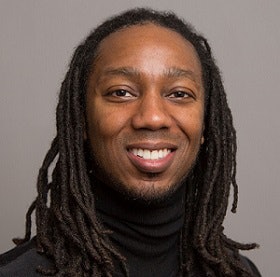A new study that follows 21 Black men pursuing graduate degrees in engineering explores themes of structural racism, unfair treatment, unwelcoming environments and feelings of isolation.
When Dr. Brian A. Burt, assistant professor in Iowa State University’s School of Education, was in graduate school, he noticed that African-American graduate students in STEM fields (science, technology, engineering and mathematics) seemed to spend a lot of time together. He wondered if this were a form of retention.
 Dr. Brian A. Burt
Dr. Brian A. BurtBurt also wondered what the experiences were that drove the graduate students’ need to socialize on a frequent basis. He came to realize that rather than the institution working to retain these students, these students were retaining each other.
While there is solid evidence of this experience at the undergraduate level, he found a dearth of material on graduate students and set out to investigate.
“That’s how this growing research idea came: How do students retain each other and what are they retaining each other from?” asked Burt.
He is the lead author of “Into the Storm: Ecological and Sociological Impediments to Black Males’ Persistence in Engineering Graduate Programs.”
The study, co-authored by Dr. Krystal L. Williams of the University of Alabama and Dr. William A. Smith of the University of Utah, has been published in the American Education Research Journal.
The researchers interviewed 21 Black male graduate students over a six-year period. The interviews revealed factors that significantly affected the students’ ability to succeed.
As the study progressed, Burt presented some of the findings. Time and again, people approached him to say they’d had experiences similar to study participants.
“It’s almost like I can erase the names and the institutional context,” said Burt. “The Black males I’ve met, they identify with these students. These 21 students are representative of so many more.”
What Burt and his colleagues discovered is that many of these students were the only people of color in their graduate programs. When they raised issues of concern to advisers, faculty members or non-Black peers, they were typically not taken seriously. The responses they received often suggested that they, the student, took a comment or action in a negative way that was not intended.
Some began to doubt themselves and how they interpreted negative experiences. The study documents those common situations and showcases the validity of their similar experiences.
The 21 students in the study all had high GPAs and a majority of them were not first-generation students. In fact, four of the participants had mothers who had doctoral degrees and three had fathers with doctorates.
“This research has allowed me to go in a lot of interesting directions,” said Burt. “I needed to know what they are experiencing. I realized not only in the colleges of engineering are there microaggressions happening, but also very locally, in their research groups.
“I was initially focused on the students themselves; I’ve now gotten more clarity on colleges of engineering as organizations. Thinking from an organizational perspective, the policies and practices and how those have implications on the success of Black men.”
Individuals can learn how to be strong, persevere and succeed despite barriers. The study explores some of the participants’ techniques and coping mechanisms, such as building a social group of fellow graduate students.
Burt and his colleagues suggest positive corrective action steps that should occur at the institutional level.
· Get rid of assumptions that there are no qualified Black candidates to become faculty.
· Improve recruitment and retention by admitting more Black students.
· Implement programs to help students learn how to interact with students from other cultures, and make the programs community efforts.
Burt will continue collecting data from more institutions over the next five years under his National Science Foundation CAREER Award.
In addition to talking to students, he wants to interview and learn more from faculty members of color at those institutions. Some of those faculty were the first-ever faculty members of color at either their present institutions or somewhere they previously taught. Just as with the students, there are common threads among the faculty hat show the systemic nature of these issues.
“There needs to be more faculty of color because…students have to see themselves represented at the highest levels,” said Burt. “Students also need more people who look like them for study groups, and have people to hang out with where they can be themselves.
Burt added that faculty “have to start reimagining what merit looks like at the graduate level. If we can re-imagine what creativity looks like in an admissions process, I can only imagine who would be included in admissions if we reconsidered what success could look like in an engineering graduate student.”



















